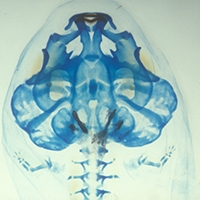Citation:
| 1.9 MB |
Abstract:
The origin and evolution of the vertebrate skull have been topics of intense study for more than two centuries. Whereas early theories of skull origin, such as the infl uential vertebral theory, have been largely refuted with respect to the anterior (pre-otic) region of the skull, the posterior (post-otic) region is known to be derived from the anteriormost paraxial segments, i.e. the somites. Here we review the morphology and development of the occiput in both living and extinct tetrapods, taking into account revised knowledge of skull development by augmenting historical accounts with recent data. When occipital composition is evaluated relative to its position along the neural axis, and specifi cally to the hypoglossal nerve complex, much of the apparent interspecifi c variation in the location of the skull– neck boundary stabilizes in a phylogenetically informative way. Based on this criterion, three distinct conditions are identifi ed in (i ) frogs, (ii ) salamanders and caecilians, and (iii ) amniotes. The position of the posteriormost occipital segment relative to the hypoglossal nerve is key to understanding the evolution of the posterior limit of the skull. By using cranial foramina as osteological proxies of the hypoglossal nerve, a survey of fossil taxa reveals the amniote condition to be present at the base of Tetrapoda. This result challenges traditional theories of cranial evolution, which posit translocation of the occiput to a more posterior location in amniotes relative to lissamphibians (frogs, salamanders, caecilians), and instead supports the largely overlooked hypothesis that the reduced occiput in lissamphibians is secondarily derived. Recent advances in our understanding of the genetic basis of axial patterning and its regulation in amniotes support the hypothesis that the lissamphibian occipital form may have arisen as the product of a homeotic shift in segment fate from an amniote-like condition.
Key words : skull, development, tetrapod, occiput, somites, skull– neck, homeotic transformation






